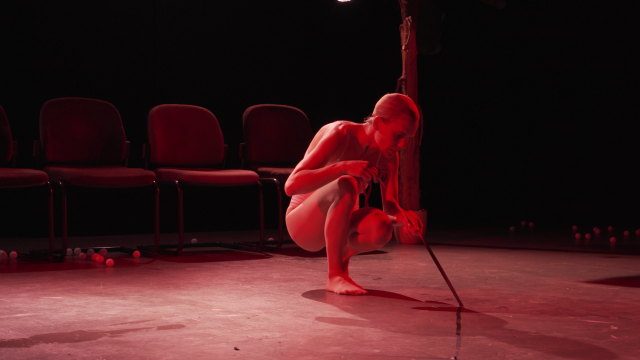And Then She Became a Chair
Michelle Myer leaves a message for the audience on the little tables in each of Theatre Works Glasshouse Perspex booths: ‘this show is about my mother dying of cancer thanks, Michelle xx’ This gives us something to hang onto in what follows. But, of course, it also betrays an anxiety that maybe we won’t ‘get it’.
In a press release, Ms Myer tells us ‘…this work is an abstract expedition into the bewildering realms of human behaviour… the peculiar ways in which we conduct ourselves when confronted with the inevitable, yet unfamiliar, event of death.’ And Then She Became a Chair is a work about grief, or dealing with grief, or dealing with grief by avoiding, evading or denying grief. It tells its story backwards, so that the cause of grief, the ‘event of death’ is withheld from us until the end, when it is revealed in a simple, vivid and beautifully written and performed speech filled with specific concrete detail.
However, up to that reveal, the show is indeed ‘abstract’ (at times too much so), proceeding in a series of images or vignettes, punctuated by blackouts and bursts of Andrew Stark’s discomforting, ‘industrial’ sound design. These vignettes dramatize or represent those ‘peculiar ways in which we conduct ourselves’. But they are not, in fact, ‘peculiar ways’ we necessarily have in common, although we might recognise the needs and wants that drive them. This is a highly individual, ‘out there’ work, and the ‘peculiar ways’ are those of Michelle Myer – which does not make them any the less valid. Her set – four rows of white chairs, some sterile indoor plants, a fishbowl – she describes as a ‘seemingly eternal waiting room’ – but it is a state, not a room. It is a state in which one waits for the grief to end and, meanwhile, one does things – those 'peculiar ways’: transform ourselves, try out roles, be silly, become desperate, become hysterical, become self-destructive, realise that none of those ‘ways’ achieve more than temporary, momentary distraction and emerge, as it were, into the clarity of facing ‘what happened’ – what really happened.
The mode is set at the start with one of her strangest – and clearest – metaphorical images. In light so dim we can hardly see her, she trudges on stage, one heavy step after another, dragging small but very heavy weights behind her, her head inside a hessian bag – and she collapses exhausted. Moments later, she strips off her negligee and sprawls on a row of chairs, half naked, washed-out, indifferent, slumped, too depressed to move, … but then jumping up to pull on a bright red swimsuit and bright red lipstick, stuffing ‘falsies’ into the bra, and donning an ash-blonde wig. It is a transformation: suddenly paralysed Michelle is manic, phoney-vivacious, phoney-sexy, writhing, dancing, spruiking a holiday resort called Paradise Palms – her patter like a broken record, repeating and repeating… until that defeats her too. Later, there comes the reading of a eulogy (at which point we may realise the story is being told backwards) and the fishbowl becomes the shrunken world of a lawyer’s office for the reading of a will.
But there are other moments where, to be honest, I could not grasp or engage, such as grating an unpeeled pineapple, or tipping over a basket of yellow balls so that they bounce and roll all over the stage.
Jahman Davine is the Dramaturg here as well as the Associate Director and Lighting Designer. For me some further dramaturgy and direction are necessary. In addition to the often random-seeming, arbitrary order of things, the rhythm feels off. Some vignettes are much too quick – or is that all there is to them? Others go on rather longer than they need to, vitiating their impact. When we are lost, the show drags and we just have to wait until it lurches back into comprehensible.
Nevertheless, despite its somewhat at times opaque nature, And Then She Became a Chair is reaching for something elusive and although its reach may exceed its grasp at times, what we have is a courageous self-revelatory and serious performer, on stage alone for around fifty-five minutes, exposing via metaphor and image, the most painful and intimate feelings. The show was first performed in Berlin and ‘remounted’ here at Theatre Works. I am curious to see it develop further.
Michael Brindley
Subscribe to our E-Newsletter, buy our latest print edition or find a Performing Arts book at Book Nook.

